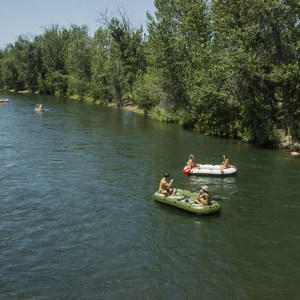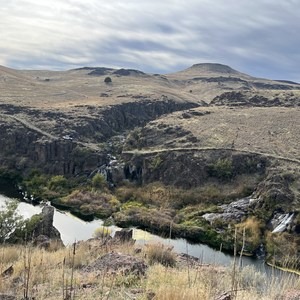You are here
Long before Boise was Idaho's capital city, it was a crucial outpost along the Oregon Trail. It's where westward-bound settlers would finally see trees and flowing water, after days of travel across the dry prairie. They could stock up supplies here, before the next leg of the journey over the mountains. Boise did present a significant obstacle, however, in the form of sheer cliffs guarding the river valley. The topography is such that the rocks form multiple tiers, or benches, above the river. Oregon Trail pioneers had to find a way for the wagons to navigate through the benches.
The route they found would become the main passage for tens of thousands of settlers to reach the Boise River, and thus continue their journey toward Oregon. Today, their tracks––yes, the actual ruts from the wagon wheels––are preserved at the Oregon Trail Reserve in Southeast Boise, and you can walk right in them on the recreational trails. The reserve is divided in two by Highway 21. North of the highway you can hike through the cliffs on a hewn-out pathway called the Kelton Ramp, while overlooking the city.
The area south of the highway has even more trails, however, and views from even taller cliffs. These are the Boise River overlooks, where you can stand on the rim of ancient lava flows and watch the river carving through the canyon below. Some of the paths follow the actual wagon ruts, and lead to another ramp through the basalt. From the trailhead you can take either the Kelton Freight Trail or the Ezra Meeker Loop. These both link with Joel Palmer Trail, which is the one that goes up to the best overlooks. By peering off the cliffs you'll see straight down to the river, where a diversion dam forms an elongate reservoir and begins Boise's biggest canal. You'll get views up and down the canyon, with the city sprawling to one side, and mountains rising on the other.
The trails here are more rugged than the ones on the north side of the reserve, and they quickly become muddy after rain or snow. Please save these for a dry day, so that your footsteps or tire tracks don't further deteriorate the historic trail. Also keep in mind that the terrain is quite exposed, with no protection from the weather. It tends to be extra cold here in winter and extra hot in summer. When you start hiking you'll soon realize there are more paths than what's marked on the map, so you might enjoy exploring alternate routes. It's not a huge area so there's no risk of getting lost. Just be sure to use caution near the cliffs, especially if hiking with children or dogs.








Comments
Sign In and share them.